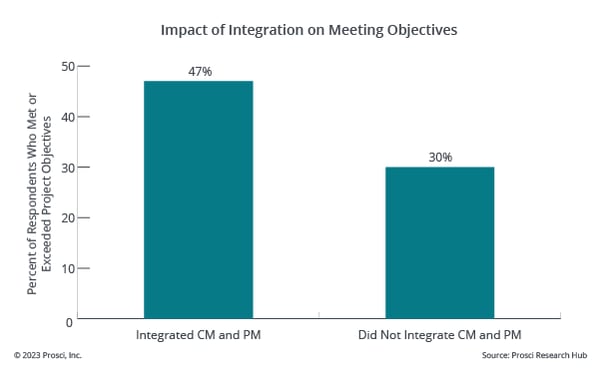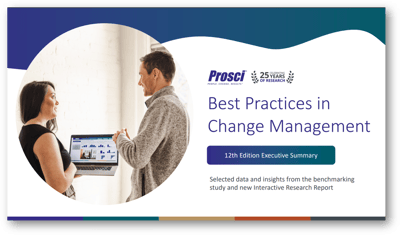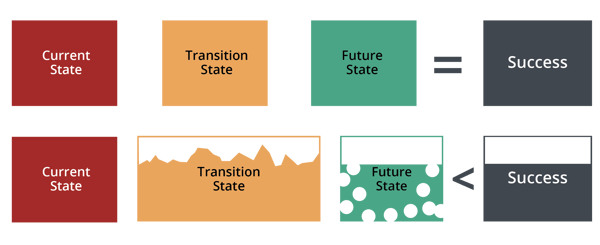6 Things We Know About Results and Change

4 Mins
Updated: March 5, 2024
Published: August 9, 2023

What do we know already about results and how change happens? How do we adapt and adjust our knowledge to better serve us in the changing world we live in today? Although we have different circumstances and experience as people, we experience successful change similarly. Grounding ourselves in what we know about change and results can help us achieve greater success going forward.
Do you need to adapt your change management approach for a must-win initiative?
Prosci Advisory Services is here to support you.
Change Management
and Grounding Ourselves
Today, we often find ourselves working with shifting transitions and unknown future states. We can be successful with change management when we ground ourselves in six things we know about results and change:
1. Prioritize the context of a change
As human beings, we rely on context to give meaning to our experiences. Consider, for instance, a water molecule consisting of a single oxygen atom and two hydrogen atoms. However, when we observe water within the context of a river, we must also recognize its significance as a vital source of life for an entire ecosystem and a fundamental part of the intricate web of interconnected living beings.
Context gives us with clarity, purpose, awareness, and direction, guiding us to make sense of the changes happening around us. Providing context helps others know where to put spend their finite time, energy, mindshare and focus. How does a change relate to all the other change we’re managing? How does it relate to organizational strategy and direction? How is it anchored to our values, who we are, and our purpose as an organization?
2. Understand the reason for the change
Effective change management always begins with a reason, and we must understand it. Your job as a practitioner is to bring it forward in a compelling way. Karen Ball’s webinar, "Craft a Compelling 'Why' to Inspire Action," explains why creating a compelling why for change is so essential and how to present it to the rest of your organization.
A compelling why resonates with individuals on various levels. A logical why presents the rationale for change using facts, figures, features and lists. An emotional why touches the heart through principles, values, beliefs or personal identity. A visual why translates destinations, steps, progress and benefits into graphics, images or other visual representations that people can easily comprehend. Lastly, a narrative why allows you to connect with individuals as human beings by combining imagination, context, actions, and results into a persuasive justification for change.
3. Align the two sides of change
The third thing we know to be true about results and change is we must bring together the people side and technical sides if we want to be successful, and they must stay in lock step with each other.
As we design, develop and deliver on the technical side of a change, employees engage with, adopt and use the solution on the people side using the ADKAR Model to work through the milestones of Awareness, Desire, Knowledge, Ability and Reinforcement.
In our Best Practices in Change Management research, 74% of respondents integrated change management with project management, which correlates with meeting project objectives 47% of the time. Those who did not integrate met objectives only 30% of the time. Participants most commonly integrated people and processes dimensions at 86% and 79% respectively.
We also need to consider the complexity of the technical side and people side. In other words, how big of a challenge do we expect when we design, develop and deliver a solution to meet technical needs? And how big of a challenge do we expect to ensure that employees engaged with, adopt and use the solution?
4. Define success for the change
Defining success is the flag on the horizon, what we’re setting out to achieve. The sponsor’s role is to clearly articulate why by defining what we want to achieve when we put time, energy, financial resources and people into the project or initiative. The practitioner plays the role of extracting and then packaging that definition of success, so we can bring it forward to the rest of the organization.
To be successful, every definition of success needs two parts: the project objectives (what the project achieves) and the organizational benefits (what the organization gains).
The definition of success will change as conditions change, and we must be ready for that. This is especially true with today’s shorter time horizons. But we can't let this keep us from defining success to get the alignment we need.
The 12th edition of Prosci's Best Practices in Change Management interactive research report includes new sections on Defining Change Success, Roles in Defining Change Success, and Defining Success Metrics. Lack of a  clear definition of success was a top obstacle for change leaders who participated in the study. Among projects that met or exceeded objectives, the top adaptation made to defining change success was to metrics and measuring success, followed by adaptations to communications and training. To inform your work with specific and customized insights, you can access the complete data and dozens of comments from participants, in their own words, in Research Hub.
clear definition of success was a top obstacle for change leaders who participated in the study. Among projects that met or exceeded objectives, the top adaptation made to defining change success was to metrics and measuring success, followed by adaptations to communications and training. To inform your work with specific and customized insights, you can access the complete data and dozens of comments from participants, in their own words, in Research Hub.
5. Focus on adoption and usage of change
We must focus on adoption and usage because that's where results come from. If we don't support and equip and prepare our people to successfully adopt and use the change, we get a Swiss-cheese future state and bumpy transition states.
Remember, the Swiss-cheese future state is when Andre, Becky, Carlos and Dharma don't all make it to the future state. When we defined the future state, decided to fund the charter or project, and made return-on-investment assumptions, we did so believing we would realize the full future state. But change doesn't happen by chance. We must prepare, equip and support our people. If we don’t, we experience frustration, failure, chaos, confusion, inconsistency, inefficiencies, anxiety, friction and more, which make the change suboptimal.
Prosci's States of Change
6. Realize desired results and outcomes from change
The last thing we know to be true is that we realize desired results and outcomes if all the pieces come together. We call this the Unified Value Proposition because the value we strive for is achieving results and outcomes in times of change.
Capturing people-dependent portion of ROI and value is the name of the game. It's why the discipline of change management exists. It's the value you can bring as practitioners. And to achieve the value of change, we need much higher levels of employee adoption and usage.
Unified Value Proposition
Achieve Results With Change Management
The last few years left lasting impacts on the discipline and how we manage change, and we need to adapt our perspectives. Whether it's a DEI initiative, organizational restructuring, enterprise software implementation, or a complete digital transformation, we have a huge opportunity to help people through their change journeys by leveraging what we already know about achieving results from change.



